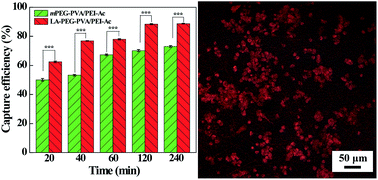Capturing hepatocellular carcinoma cells using lactobionic acid-functionalized electrospun polyvinyl alcohol/polyethyleneimine nanofibers†
Abstract
We report a facile approach to immobilizing lactobionic acid (LA) onto electrospun polyvinyl alcohol (PVA)/polyethyleneimine (PEI) nanofibers through a polyethylene glycol (PEG) spacer for capturing hepatocellular carcinoma cells. In this work, electrospun PVA/PEI nanofibers were crosslinked using glutaraldehyde vapor, covalently conjugated with PEGylated LA via an N-(3-dimethylaminopropyl)-N′-ethylcarbodiimide hydrochloride (EDC) coupling reaction, followed by acetylation of the remaining PEI amines on the fiber surface. The formed LA-functionalized nanofibers were characterized via scanning electron microscopy and attenuated total reflectance-Fourier transform infrared spectroscopy. We show that the fiber morphology does not significantly change after fiber surface modification. The functionalized nanofibers display good hemocompatibility and superior capability to capture asialoglycoprotein receptor (ASGPR)-overexpressing hepatocellular carcinoma cells in vitro via a ligand–receptor interaction. The developed LA-modified PVA/PEI nanofibers may be applied to capture circulating tumor cells for cancer diagnosis applications.


 Please wait while we load your content...
Please wait while we load your content...